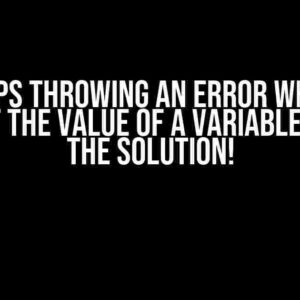Are you tired of dealing with ambiguous click events in your Leaflet maps? Do you struggle to pinpoint the exact layer or feature that triggered an action? Fear not, dear cartographer! In this comprehensive guide, we’ll delve into the world of attribution control on click events with Leaflet, empowering you to take total command of your map’s interactions.
Understanding Attribution Control: What’s the Big Deal?
Attribution control is the process of identifying and handling the source of a click event on a map. This is crucial when working with multiple layers, features, or overlays, as it allows you to respond accordingly to user interactions. Without attribution control, you’re basically flying blind, unable to determine which layer or feature triggered the event.
The Consequences of Poor Attribution Control
- Confusion and frustration for your users, who may struggle to understand what’s happening on the map
- Inaccurate or incorrect data processing, leading to flawed insights or decisions
- Inefficient debugging and troubleshooting, as you’ll be left guessing which layer or feature is causing the issue
Setting Up Attribution Control with Leaflet
Now that we’ve covered the importance of attribution control, let’s dive into the nitty-gritty of setting it up with Leaflet. We’ll explore two primary methods: using the built-in `layer` property and leveraging the power of event listeners.
Method 1: Utilizing the `layer` Property
The most straightforward approach is to use the `layer` property, which returns the layer that triggered the click event. This method is particularly useful when working with a single layer or a small number of layers.
// Create a map and a layer
var map = L.map('map').setView([51.505, -0.09], 13);
var layer = L.tileLayer('https://{s}.tile.openstreetmap.org/{z}/{x}/{y}.png', {
attribution: '© OpenStreetMap',
subdomains: ['a', 'b', 'c']
}).addTo(map);
// Add a click event listener to the layer
layer.on('click', function(e) {
console.log('Layer clicked:', e.layer);
});
In this example, we create a map and add a tile layer. We then attach a click event listener to the layer, which logs the layer object to the console when clicked.
Method 2: Event Listeners to the Rescue
When working with multiple layers or complex overlays, using event listeners provides a more flexible and robust approach to attribution control. We can attach event listeners to specific layers or the map itself, allowing for finer-grained control over click events.
// Create a map and multiple layers
var map = L.map('map').setView([51.505, -0.09], 13);
var layer1 = L.tileLayer('https://{s}.tile.openstreetmap.org/{z}/{x}/{y}.png', {
attribution: '© OpenStreetMap',
subdomains: ['a', 'b', 'c']
}).addTo(map);
var layer2 = L.geoJSON({
"type": "Feature",
"geometry": {
"type": "Point",
"coordinates": [-0.09, 51.505]
},
"properties": {
"name": "Layer 2"
}
}).addTo(map);
// Add a click event listener to the map
map.on('click', function(e) {
// Check which layer was clicked
if (e.layer === layer1) {
console.log('Layer 1 clicked');
} else if (e.layer === layer2) {
console.log('Layer 2 clicked');
} else {
console.log('Unknown layer clicked');
}
});
In this example, we create a map with two layers: a tile layer and a GeoJSON layer. We then attach a click event listener to the map, which checks the `e.layer` property to determine which layer was clicked.
Advanced Attribution Control Techniques
Now that we’ve covered the basics, let’s explore some advanced techniques to take your attribution control to the next level.
Using `leaflet-layer` Classes
Leaflet provides a range of classes for working with different types of layers, such as `L.TileLayer` and `L.GeoJSON`. By using these classes, you can create custom layers with specific attribution control logic.
// Create a custom layer class with attribution control
var CustomLayer = L.Class.extend({
initialize: function(options) {
this.options = options;
},
onAdd: function(map) {
this.map = map;
this.map.on('click', this._onClick, this);
},
onRemove: function(map) {
this.map.off('click', this._onClick, this);
},
_onClick: function(e) {
console.log('Custom layer clicked:', e.layer);
}
});
// Create an instance of the custom layer
var customLayer = new CustomLayer({
attribution: 'Custom layer © 2023'
}).addTo(map);
In this example, we create a custom layer class with an `onAdd` method that attaches a click event listener to the map. The `_onClick` method logs the custom layer object to the console when clicked.
Handling Click Events on Overlays
When working with overlays, such as polygons or circles, you may want to handle click events on specific overlay elements. Leaflet provides an `overlayPane` property that allows you to target specific overlays.
// Create a map and an overlay
var map = L.map('map').setView([51.505, -0.09], 13);
var overlay = L.polygon([
[51.505, -0.09],
[51.50, -0.05],
[51.50, -0.14]
]).addTo(map);
// Add a click event listener to the overlay pane
map.getPane('overlayPane').addEventListener('click', function(e) {
// Check which overlay was clicked
if (e.target === overlay) {
console.log('Overlay clicked');
}
});
In this example, we create a map and add a polygon overlay. We then attach a click event listener to the `overlayPane`, which checks the `e.target` property to determine which overlay was clicked.
Conclusion
Mastering attribution control on click events with Leaflet is a crucial skill for any cartographer or GIS professional. By following the techniques outlined in this guide, you’ll be well-equipped to handle complex map interactions with confidence.
Remember to experiment with different approaches and adapt them to your specific use case. With attribution control, you’ll unlock the full potential of your Leaflet maps, providing a better user experience and more accurate data insights.
| Method | Description |
|---|---|
| Using the `layer` property | Returns the layer that triggered the click event |
| Event listeners | Attach event listeners to specific layers or the map for finer-grained control |
| Leaflet layer classes | Create custom layers with specific attribution control logic |
| Handling click events on overlays | Target specific overlays using the `overlayPane` property |
Don’t settle for ambiguous click events – take control of your Leaflet maps today!
Frequently Asked Questions
-
Q: Can I use attribution control with multiple layers?
A: Yes, you can use event listeners to target specific layers or the map itself, allowing for finer-grained control over click events.
-
Q: How do I handle click events on overlays?
A: You can use the `overlayPane` property to target specific overlays and attach event listeners to the overlay pane.
-
Q: Can I create custom layers with attribution control?
A: Yes, you can create custom layers using Leaflet’s layer classes and implement specific attribution control logic.
Frequently Asked Question
Learn how to establish attribution control on a click event with Leaflet and take your mapping skills to the next level!
What is attribution control in Leaflet, and why do I need it?
Attribution control in Leaflet refers to the ability to control the attribution text that appears when a user clicks on a feature or marker on the map. You need attribution control to comply with licensing terms, give credit to data providers, and maintain transparency in your mapping application.
How can I set up attribution control on a click event using Leaflet?
To set up attribution control on a click event, you can use the `onEachFeature` method when creating a Leaflet layer. This method allows you to specify a function that will be called when a feature is clicked. Inside this function, you can use the `layer.bindPopup` method to create a popup with the attribution text.
Can I customize the attribution text and its placement on the map?
Yes, you can customize the attribution text and its placement on the map using Leaflet’s options and methods. For example, you can use the `popupOptions` object to customize the popup’s appearance and behavior. You can also use Leaflet’s built-in support for HTML in popup content to create rich attribution text with links, images, and more.
How can I handle multiple attributions for different layers and features?
To handle multiple attributions for different layers and features, you can use Leaflet’s layer groups and the `layer.bindPopup` method with a conditional statement to determine which attribution text to display based on the clicked feature or layer. You can also use separate layers for each data source and set up attribution control for each layer individually.
Are there any best practices for attribution control in Leaflet that I should follow?
Yes, there are several best practices to follow when implementing attribution control in Leaflet. These include using clear and concise attribution text, making sure attributions are easily accessible to users, and following the licensing terms of your data providers. Additionally, consider providing a link to the data source or a terms of use page to maintain transparency.



